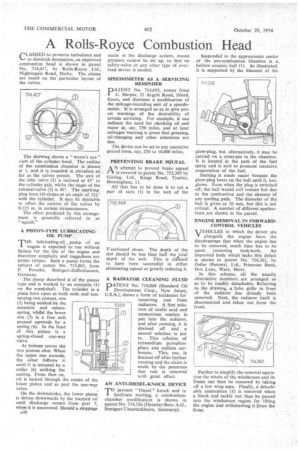A Rolls-Royce Combustion Head
Page 66

If you've noticed an error in this article please click here to report it so we can fix it.
CLAIMED to promote turbulence and *4-• to diminish detonation, an improved combustion head is shown in patent No. 714,417„ by Rolls-Royce Ltd., Nightingale Road, Derby. The claims are based on the particular layout of the valves.
The drawing shows a " worm's eye " view of the cylinder head. The outline of the combustion chamber is shown at 1, and it. is sounded in elevation so far as the valves permit. The axis of the inlet valve (2) is inclined at 45° to the cylinder axis, whilst the angle-of the exhaust-valve (3) is 40°. The sparkingplug bore (4) slopes,at an angle of 121° with the cylinder. It may be desirable to offset the centres of the valvesby
0.125 in. in certain circumstances. • The effect produced by this arrangement is generally referred to as " squish."
A PISTON-TYPE LUBRICATING.' OIL PUMP •
THE lubricatingzoil pump of an engine is expected to run without failure for the life of the engine and therefore simplicity and ruggedness are prime virtues. Such a pump forms the subject of patent No. 713,801, from F. Porsche, Stuttgart-Zuffenhausen, Germany.
The pump described is of the piston type and is worked by an eccentric (1) on the crankshaft. The cylinder is a plain bore open atboth ends and containing two pistons, one (2) being worked by the eccentric and returnspring. whilst the lower one (3) is a free unit pressed upwards by a spring (4). In the head of this piston is a spring-closed one-way valve.
At bottom centre the two pistons abut. When the upper one ascends. the other follows it until it is arrested by a collar (6) straing the casting. From then on, oil is sucked through the centre of the lower piston and so past the one-way valve.
On the downstroke, the lower piston is driven downwards by the trapped oil until discharge occurs from port 7, when it is uncovered. Should a stoppage A40 occur in the discharge system, excess pressure cannot be set up, so that no safety-valve or any other type of overload device is needed.
SPEEDOMETER AS A SERVICING REMINDER
PATENT No. 714,695, comes from C. Harper, 32 Argyle Road, Ilford, Essex, and discloses a modification of the mileage-recording unit of a speedometer. It is arranged so as to give preset warnings of the desirability of certain servicing. For example, it can indicate the need for checking ail and water at, say, 250 miles, and at later mileages warning is given that greasing, oil-changing and other attentions are due.
The, device can be set to any operative period from, say, 250 to 10,000 miles.
PREVENTING BRAKE SQUEAL
A N attempt to prevent brake squeal is covered in patent No. 712,369 by Girling, Ltd., Kings Road, Tyseley, Birmingham, 11.
AB that has to be done is to cut a pair of slots (1) in the web of the T-sectioned shoes. The depth of the slot should be less than half the total depth of the web. This is clamed to have been successful in either eliminating squeal or greatly reducing it.
A RADIATOR CLEANING FLUID
PATENT No. 714,068 (Standard Oil Development Corp., New Jersey, U.S.A.), shows a form of treatment for removing rust from radiators. A first solution of oxalic acid and ammonium oxalate is put into the radiator, and after running, it is drained off and a second solution is put in. This consists of tetrasodium pyrophosphate and sodium carbonate. This, too, is drained off after further running and the claim is made by the patentees that rust is removed with great effect.
AN ANTI-DIESEL-KNOCK DEVICE
ri° prevent "Diesel" knock and to facilitate starting, a combustionchamber modification is shown in p3tent No. 714,126 (Daimler-Benz A.G., Stuttgart-Untertiirkheim, Germany).
Suspended in the approximate centre of the pre-combustion'Chamber is a, hollow ceramic ball (1). As illustrated, it is supported by the filament of the glow-plug, but, alternatively, it may be carried on a cross-pin in the chamber. It is located in the path of the fuel spray and is said to promote intensive evaporation of the fuel.
Starting is made easier because the glow-plug heats up the ball until it, too, glows. Even when the plug is switched off, the ball would still remain hot due to the combustion and the absence of any cooling path. The diameter of the ball is given as 10 mm. but this is not critical. A number of different applications are shown in the patent.
ENGINE REMOVAL IN FORWARDCONTROL VEHICLES
VTEHICLES in which the driver sits V alongside the engine have the disadvantage that when the engine has to be removed, much time has to be spent removing bodywork. An improved body which lacks this defect is shown in patent No. 714,362, by Ostler (Patents), Ltd., Primrose Bank, Hoe Lane, Ware, •Herts.
In this scheme, all the usually obstructive members are arranged so as to be readily detachable. Referring to the drawing, a false grille in front of the radiator has already been removed. Next, the radiator itself is disconnected and taken out from the front.
Further to simplify the removal operation-the whole of the windscreen and its frame can then be removed by taking off a few wing nuts. Finally, a detachable centrepiece (1) is removed when a block and tackle can then be passed into the windscreen region for lifting the engine and withdrawing it from the front.




























































































